Kashmir is often called “paradise on earth,” and most people will agree that it’s the best place to go hiking in the Himalayas. Compared to the others, it is clear that Tarsar Marsar Trek is the best. The impressive Tarsar Marsar Trek is at an altitude of 4,023 m (13,201 ft) and has two beautiful alpine lakes: Tarsar and Marsar.
Tarsar Marsar Lake Trek
The almond-shaped Tarsar Lake, known as Tar Sar, is in the Anantnag district of Jammu and Kashmir. The trek starts from Aru valley. This oligotrophic and alpine lake is a popular place for trekkers. The Tarsar Marsar trek trail traverses through snow-capped mountains and open meadows. Watching the unhurried happening of pastoral life is indeed a treat to the eyes. Between the Tarsar and its sister lake, Marsar, lies a huge mountain with an elevation of 4,023 m (13,123 ft).
Marsar Lake is an oligotrophic lake in the state of Jammu and Kashmir. It is situated in the Tral Valley in the Pulwama district. In the local language, Marsar means “kill lake” (mar means “kill” and “sar” means “water”). Marsar Lake is mostly covered in clouds. It seems as though it is a very secret place covered in clouds. If you get lucky, you might spot a mind blowing view from a distance- the view of a gorgeous lake being uncovered by the clouds. This super-filmy view is capable of taking away your prolonged tiredness within seconds!

B. Why should you go trekking in Kashmir
Kashmir’s ethereal beauty is hard to deny, and it is because of this, many nature lovers, trekkers, and tourists are drawn to the area. The state’s beautiful scenery includes snow-covered mountains, kush-green meadows, gushing rivers, tall trees, beautiful alpine lakes, and much more. Kashmir has beautiful scenery and several well-known trek trails that traverse through the Himalayas. The trek to Tarsar Marsar lakes is one of them. On the Tarsar Marsar Lake trek, you can easily spot some of the rare flora and fauna such as the kashmiri iris and the himalayan marmot.
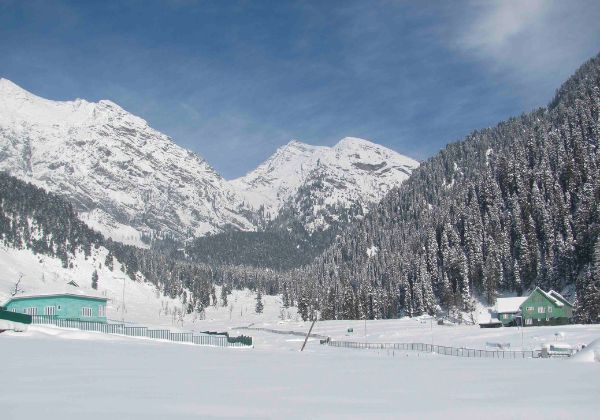
C. Importance of trekking Kashmir in 2023
Kashmir is a beautiful region located in the northern part of the Indian subcontinent, known for its breathtaking scenery, high mountains, and stunning trekking routes. The region is surrounded by the Himalayas, Karakoram, and Pir Panjal mountain ranges, and is home to several high peaks, including the famous Mount Harmukh.
There are many popular treks in Kashmir, including the Tarsar Marsar Trek, Kashmir Great Lakes Trek, and the Kolahoi Glacier Trek. These treks offer spectacular views of the mountains, glaciers, and alpine lakes, and attract trekking enthusiasts from all over the world.
Trekking in Kashmir has a long history, dating back to the 19th century when the region was first explored by British mountaineers. Today, the region is a popular destination for adventure tourism and attracts thousands of trekkers and climbers every year.
The ideal time for trekking in Kashmir is between June and September, when the weather is dry and mild. However, some treks can be undertaken during other seasons as well, depending on the route and weather conditions. It is advisable to seek the guidance of experienced trekking companies or guides to ensure a safe and enjoyable trek.

II. Overview of Tarsar Marsar Trek
A. Location and elevation
The Tarsar Marsar trek starts in the village of Aru, 12 km from Pahalgam in Kashmir. Tourists often go to the lakes of Tarsar and Marsar. These are some of the most beautiful mountain lakes in Kashmir. Kashmir’s Tarsar and Marsar Lakes are in the Anantnag area, close to Pahalgam. The Tarsar Marsar trek is a nine-day trip through some of the most beautiful parts of the Indian Himalayas. When you start trekking in the village of Aru, which is 2,484 m (8,149 ft) above sea level, you will pass through the nearby alpine meadows, forests, and rough mountains to get used to the thin air which would help in acclimatization.
On day three, you’ll start climbing up to Lidderwat, and the view of the valley and meadows are worth remembering for the rest of your life. On day 4, you’ll take a well-marked path to Shekwas that slowly goes uphill. A small but beautiful lake, Jadar, can also be reached on foot. On the fifth day of the trek, you’ll reach Tarsar Lake situated at an elevation of 3,795 m (12,450 ft). On Day 6, you get to rest for sometime and explore the Sundersar Lake. On day 7, you will finally see the beautiful Marsar Lake. On the last day of your trip, you will go down from Homwas to Aru Valley and then drive to Srinagar.
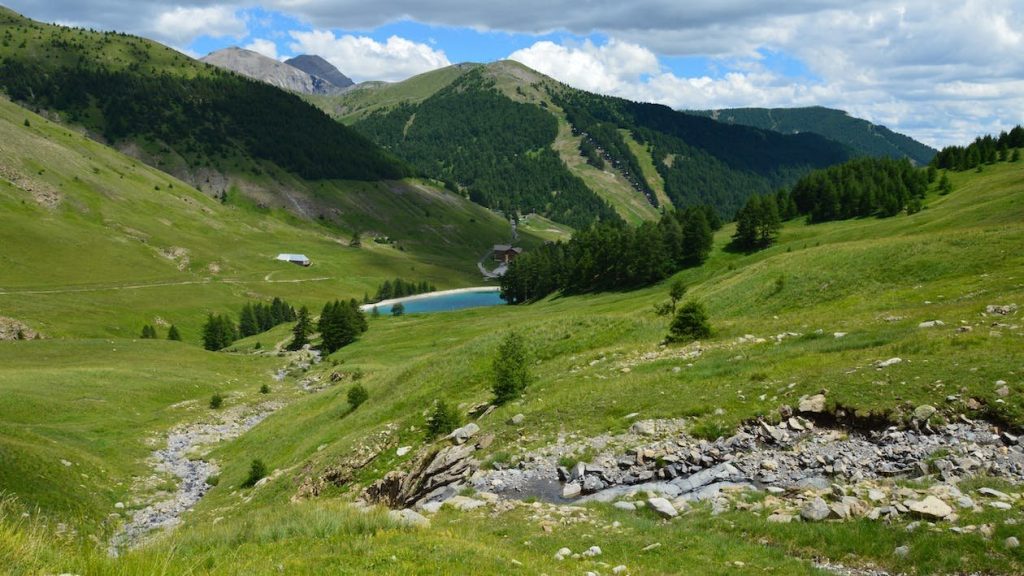
Day-wise itinerary of Tarsar Marsar Trek
- Day 1: Arrive in Srinagar (5,200 ft / 1,585 m)
- Day 2: Drive from Srinagar to Aru Valley (7,920 ft / 2,414 m)
- Day 3: Trek from Aru to Lidderwat (9,022 ft / 2,750 m)
- Day 4: Trek from Lidderwat to the Shekwas (11,154 ft / 3,340 m)
- Day 5: Trek from Shekwas to Tarsar Lake (12,451 ft / 3,795 m)
- Day 6: Trek from Tarsar Lake to Sundersar Lake via Tarsar/Sonamous Pass (12,945 ft (3,946 m) via ~13,120 ft (~4,000 m)
- Day 7: Trek from Sundersar to Homwas via Marsar Lake (11,300 ft / 3,444 m) via (13,165 ft / 4,013 m)
- Day 8: Trek from Homwas to Aru and Travel to Srinagar (7,920 ft / 2,414 m)
- Day 9: Departure from Srinagar
B. Distance and difficulty level of Tarsar Marsar trek
The trek will be about 48 Km long and moderately difficult. You will need to take a break so you can relax and acclimatize to the high altitudes. Trekking with guides who know what they’re doing is important. The Treknomads team will be there to make sure you complete the trek safely. At high altitudes, you are exposed to the risk of catching AMS or Acute Mountain Sickness. Make sure you obey your trek leader and take the necessary precautions.
To avoid AMS (Acute Mountain Sickness), it is recommended to ascend and descend gradually, drink plenty of water, and avoid alcohol and junk food on the trek. If symptoms of AMS develop, descending to a lower altitude is the most effective treatment.
It is extremely essential that you are physically fit for the trek. So, we suggest that you start preparing for this trek at least 2 to 3 months in advance. We have a comprehensive guide on how to get fit for a himalayan trek. You can access it here.
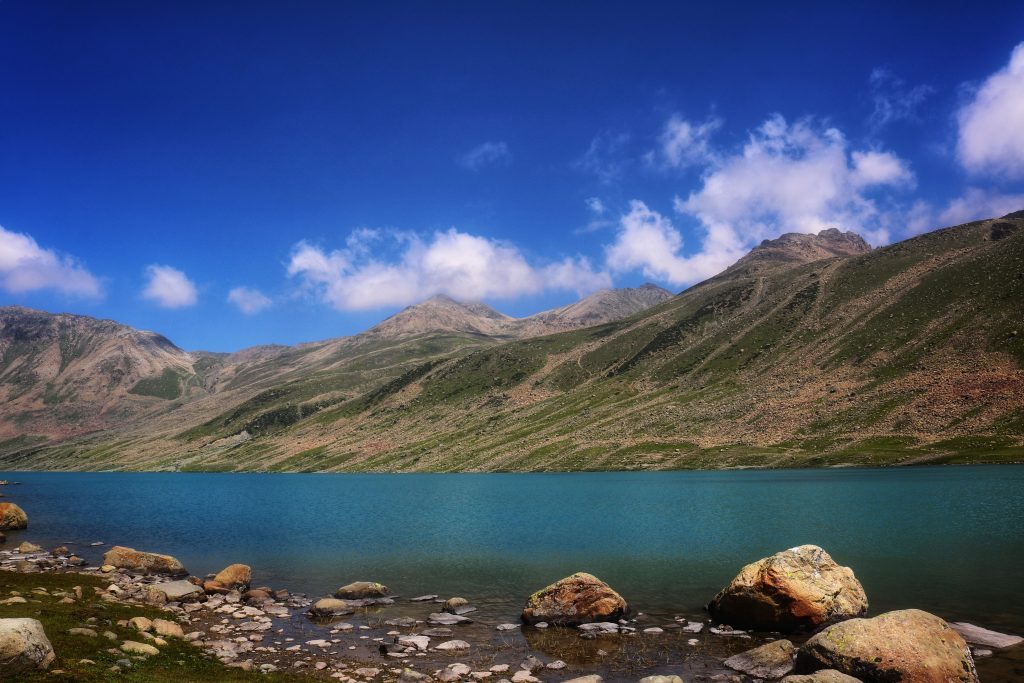
C. Weather conditions on the Tarsar Marsar trek
The weather on the Tarsar Marsar trek can vary depending on the time of year you plan to visit.
During the summer months of May to September, the weather is generally pleasant, with temperatures ranging from 10-20°C during the day and dropping to around 0-5°C at night. However, there may be occasional rain showers, especially in July and August.
In autumn (September to November), the temperatures start to drop, with daytime temperatures ranging from 5-15°C and nighttime temperatures dropping below freezing. This is a beautiful time to visit as the leaves of the trees change color, but you need to be prepared for colder weather.
In winter (December to February), the area experiences heavy snowfall, and temperatures can drop to as low as -10°C during the day and -20°C at night. This trek is not recommended during the winter months as it can be extremely challenging and dangerous.
D. When is the best time to go on the Tarsar Marsar Trek?
The best time to go on the Tarsar Marsar trek is during the summer months of May to September. This is when the weather is mild and the trail is conveniently accessible. During this time, you can expect clear skies, comfortable temperatures during the day. However, at night the temperatures can drop up to 2 to 3 degrees and it can get pretty cold.
Additionally, this is also the time when the flora and fauna in the area are at their best. You will see green meadows, wildflowers, and a variety of rare bird species such as red-crested pochard, common shelduck during this time. The views of the surrounding snow-capped mountains and glaciers are also spectacular during this time.
It is important to note that the monsoon season starts in July and continues till August, and there may be occasional rain showers during this time. So it’s recommended to pack rain gear and be prepared for some wet weather.
Trekkers should note that the weather in the mountains can be unpredictable, and you should always be prepared for sudden changes in weather conditions. Additionally, it is always recommended to check the weather forecast and seek advice from experienced trekking guides before embarking on any trek.
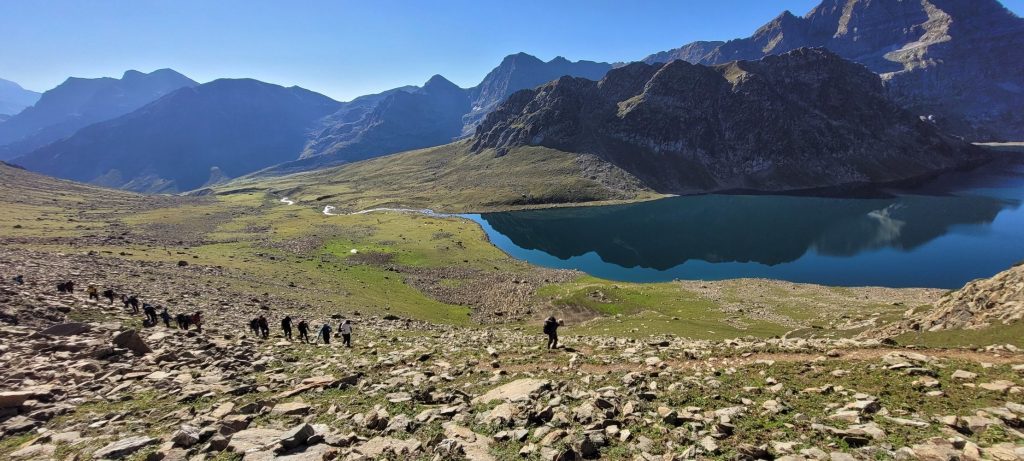
IV. Preparation for Tarsar Marsar Trek
A. Fitness level required
We at TrekNomads consider several factors to determine how difficult a trek is. Things like the daily increase in altitude, the average length of a trek, the highest point, the type of landscape, the weather, etc. This is how we determine if a trek will be easy or tough. The climb to the height of 13,201 ft is moderately tough, to be honest.
A moderately difficult trek has a few steep climbs, like the one to Tarsar Pass, and hiking days that are a little longer. Because of this, the trek is more challenging than the Kedarkantha and Dayara Bugyal trails, which are relatively simpler. Aside from acute mountain sickness, you must be careful on the steep drop from the Tarsar pass. It’s short, but getting down in the rain can be challenging. Here, it helps a lot to have good-quality hiking shoes with good grip.
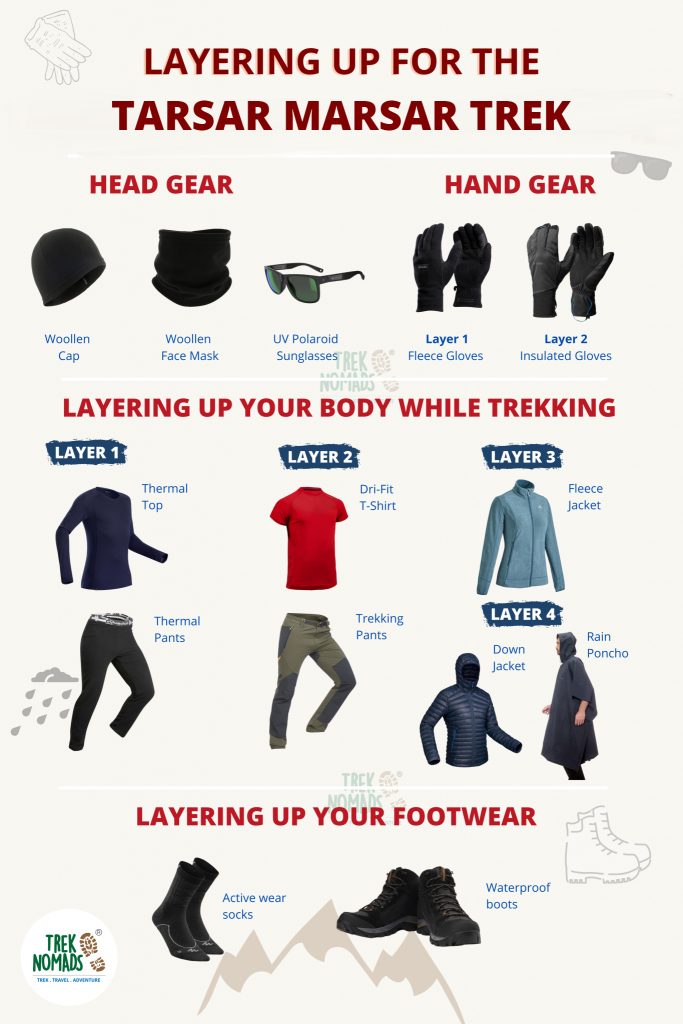
B. Required equipment
Remember the basics, when planning a trek to the Tarsar Marsar takes. A newbie trekker needs trekking boots, a raincoat, hiking stick, and a sleeping bag. Carry warm and waterproof clothes on a trek because the weather on mountains is highly unpredictable.. Bring a bottle of water, a torch, a hat, gloves, and sunscreen. Bring a camera and extra batteries to experience all the gorgeous views along the way. All the trekking gear such as walking sticks, tents, ropes, etc shall be provided by us.
C. Permit and cost
The permits required for the Tarsar Marsar trek in India are the Jammu and Kashmir government trekking permit and the Lidder Valley National Park permit. TrekNomads will help with these permits. However, we suggest you bring an ID card, documents, medical certificates, passport size photos, etc.
D. Hiring a guide or porter
If you want to avoid carrying your backpack, you can hire a porter at additional charges, But you have to keep us informed about this in advance, and you have to pay INR 300 to 350 (subject to change) extra per day per bag.
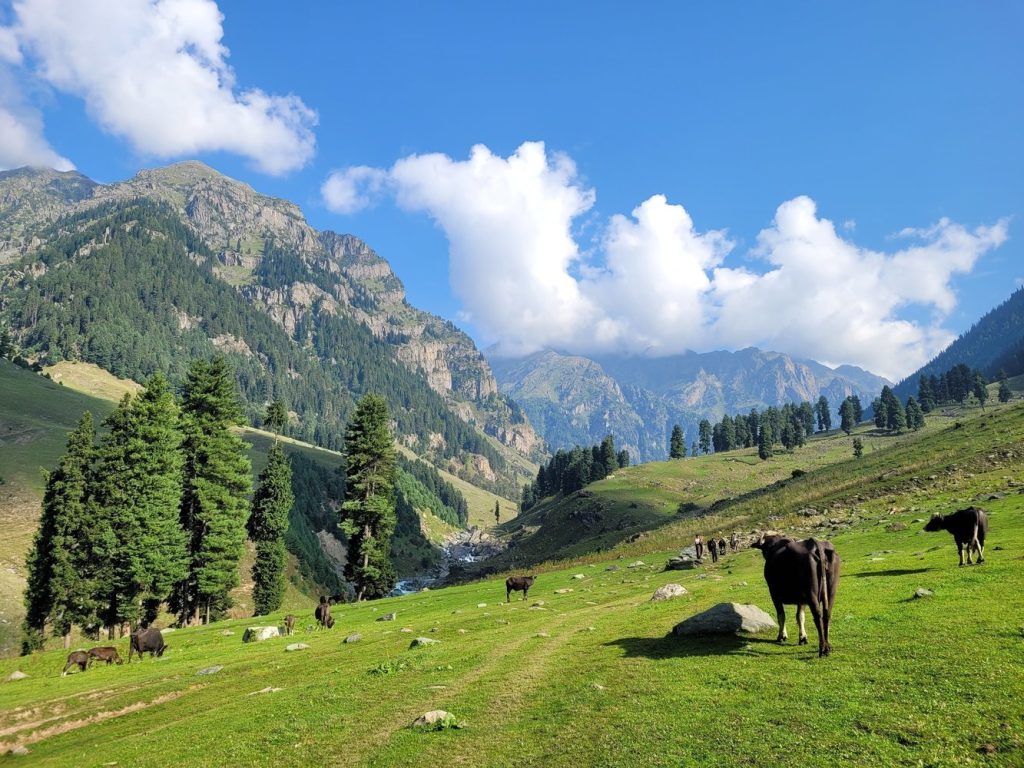
V. What to expect on the Tarsar Marsar trek
One exciting thing about the Tarsar Marsar Trek is that the color of the lake changes from bright green to different shades of blue throughout the day. This is because the angle of the sun at sunrise and sunset makes the lake visible in different colors. You can only go to the lake in the summer, but that’s okay because there are many different kinds of birds to see. Birds like black bulbul, bar-headed geese, high-flying coughs, and Himalayan golden eagles. This trek takes you through some beautiful places, like the village of Aru, where you can learn about the history and traditions of the area.
VI. Safety and health concerns
When going on a trek, you should always be careful. Some people get sick because of the high altitudes. Where the terrains are tough, the risk of accidents is also high. Dress appropriately for the weather, drink a lot of water, and take breaks as and when required. We’ll always be there to make sure you get through safely. We try our best to provide the best experience to our trekkers. Remember to bring some simple first-aid supplies with you if you get hurt. But you should see a doctor before you go on this trip.

VII. Conclusion
The Tarsar Marsar Trek is known for some of the most beautiful parts of India. Every step of this trek has a beautiful view to offer. From small towns to green hills to alpine lakes. The best parts of this trek are Tarsar and Marsar, two high-altitude mountain lakes. At an altitude of 12,500 ft, these beautiful lakes offer views that look like they are from another planet. One of the best parts of this trek is the chance to spend the night under the stars in some of India’s most beautiful campsites.
When you wake By taking out time to trek in Kashmir, you not only get to enjoy the stunning views of snow-capped mountains, glistening glaciers, and sparkling alpine lakes but also get an opportunity to challenge yourself physically and mentally. Trekking is a great form of exercise that allows you to connect with nature, reduce stress, and improve overall health and wellbeing.
So, if you’re looking for a unique adventure that combines exercise, nature, and culture, join us for the best trekking experience in Kashmir. Our experienced guides will help you navigate the trails, provide insights into the local culture, and ensure your safety throughout the trek. Whether you choose the Tarsar Marsar Trek, the Kashmir Great Lakes Trek, or any other route, we guarantee an unforgettable experience that will leave you with lasting memories in the morning, there’s nothing better than seeing a beautiful view of mountains and lakes.
Read more:
Best time for Tarsar Marsar trek
How to get fit for the himalayan trek
